California Precipitation Update – Jan ’21
Executive Summary
Recent reductions in precipitation levels have reduced snowpack and increased drought conditions throughout the state of California. Important points to consider include:
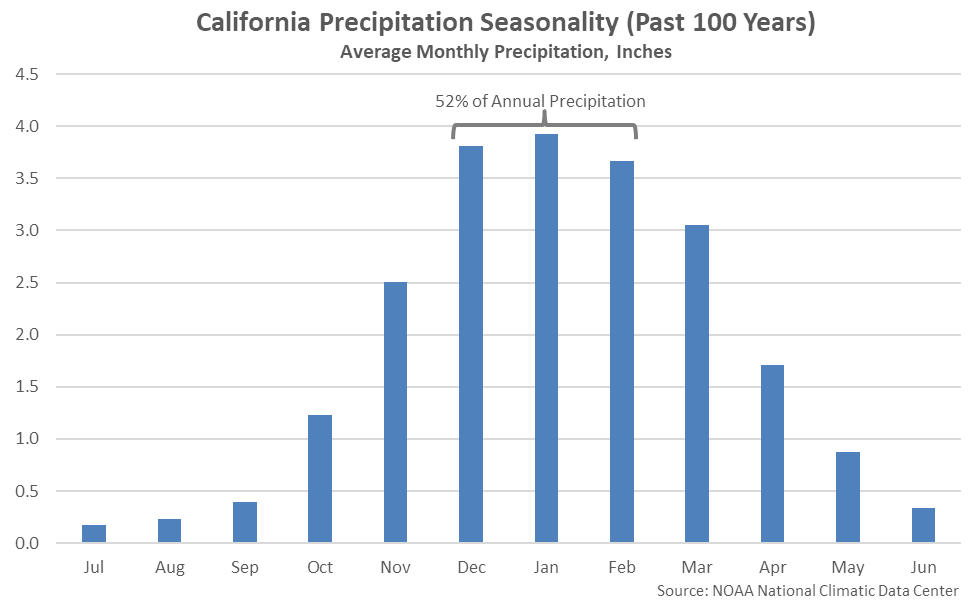 July – December cumulative precipitation levels have finished below long-term average levels over four consecutive years through 2020. Jul-Dec ’20 cumulative California precipitation levels declined to a seven year low level and the third lowest level experienced throughout 126 years of available data. Cumulative precipitation levels experienced throughout Jul-Dec ’20 finished just 0.04 inches above the record low level experienced throughout 2013, a period that was followed by extreme drought conditions.
July – December cumulative precipitation levels have finished below long-term average levels over four consecutive years through 2020. Jul-Dec ’20 cumulative California precipitation levels declined to a seven year low level and the third lowest level experienced throughout 126 years of available data. Cumulative precipitation levels experienced throughout Jul-Dec ’20 finished just 0.04 inches above the record low level experienced throughout 2013, a period that was followed by extreme drought conditions.
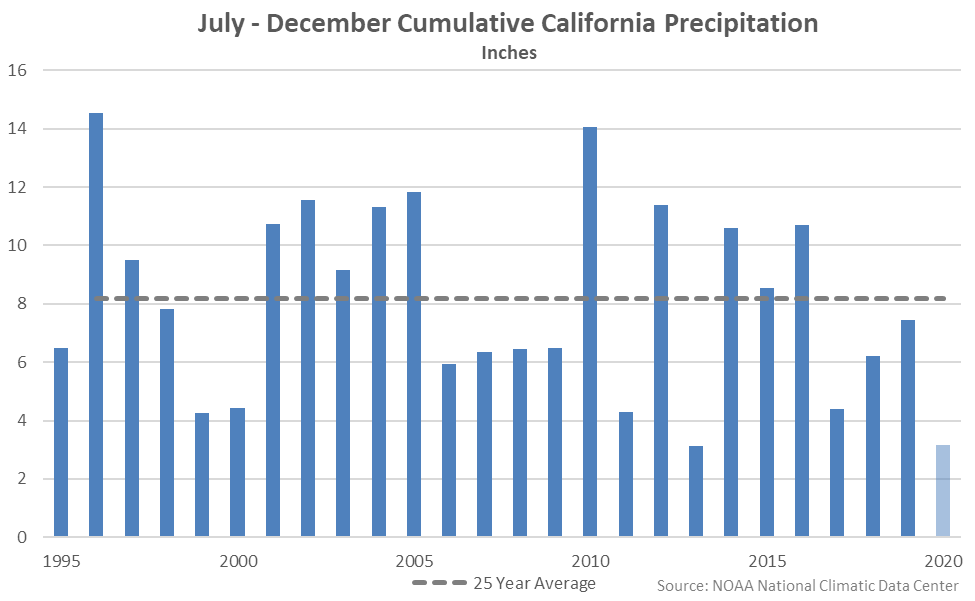 Precipitation experienced throughout the winter months is typically in the form of snow in the Sierra Nevada Mountains, which serves to refill reservoirs and canals during the summer and early fall months. California snowpack levels typically start to accumulate at the beginning of California’s wet season in early December and peaks in early April following California’s heavy precipitation months. From April to June, warmer temperatures cause the snow to gradually melt and run off, filling the state’s water reservoirs. California relies on the snowpack for water during the dry summer and early fall months, when precipitation levels are at seasonal lows. According to the National Resources Defense Council, on average, snowpack accounts for approximately 30% of the water used by California’s cities and farms each year.
Reduced precipitation levels experienced throughout the current California wet season have contributed to average snowpack declining to a three year low seasonal level through mid-January.
Precipitation experienced throughout the winter months is typically in the form of snow in the Sierra Nevada Mountains, which serves to refill reservoirs and canals during the summer and early fall months. California snowpack levels typically start to accumulate at the beginning of California’s wet season in early December and peaks in early April following California’s heavy precipitation months. From April to June, warmer temperatures cause the snow to gradually melt and run off, filling the state’s water reservoirs. California relies on the snowpack for water during the dry summer and early fall months, when precipitation levels are at seasonal lows. According to the National Resources Defense Council, on average, snowpack accounts for approximately 30% of the water used by California’s cities and farms each year.
Reduced precipitation levels experienced throughout the current California wet season have contributed to average snowpack declining to a three year low seasonal level through mid-January.
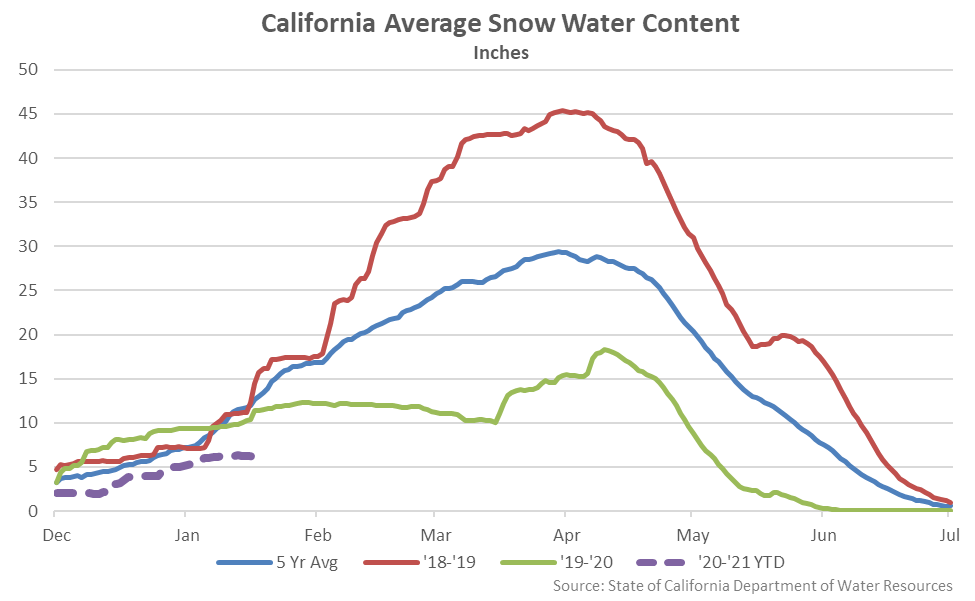 California snowpack levels rebounded to above historical average seasonal December levels for the first time in the past seven years throughout 2019. Dec ’20 California snowpack declined to just 45% of normal levels, however, reaching a three year low seasonal level.
California snowpack levels rebounded to above historical average seasonal December levels for the first time in the past seven years throughout 2019. Dec ’20 California snowpack declined to just 45% of normal levels, however, reaching a three year low seasonal level.
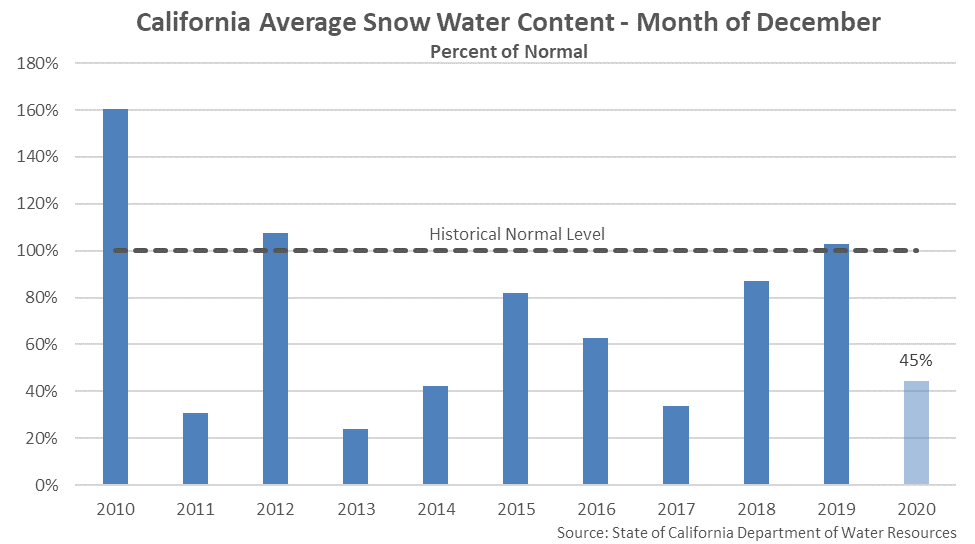 California Drought Monitor
Increases in precipitation levels experienced throughout the first quarter of 2019 largely eliminated drought conditions throughout the state of California. More recently, reduced precipitation levels have once again increased drought conditions throughout the vast majority of California. Over 95% of California was deemed to be in a moderate or worse drought through mid-January, reaching a four and a half year high level. Nearly 40% of California is currently in an extreme drought classification or worse, reaching a four year high level, while exceptional drought conditions were experienced throughout California for the first time in the past three and a half years during mid-December.
California Drought Monitor
Increases in precipitation levels experienced throughout the first quarter of 2019 largely eliminated drought conditions throughout the state of California. More recently, reduced precipitation levels have once again increased drought conditions throughout the vast majority of California. Over 95% of California was deemed to be in a moderate or worse drought through mid-January, reaching a four and a half year high level. Nearly 40% of California is currently in an extreme drought classification or worse, reaching a four year high level, while exceptional drought conditions were experienced throughout California for the first time in the past three and a half years during mid-December.
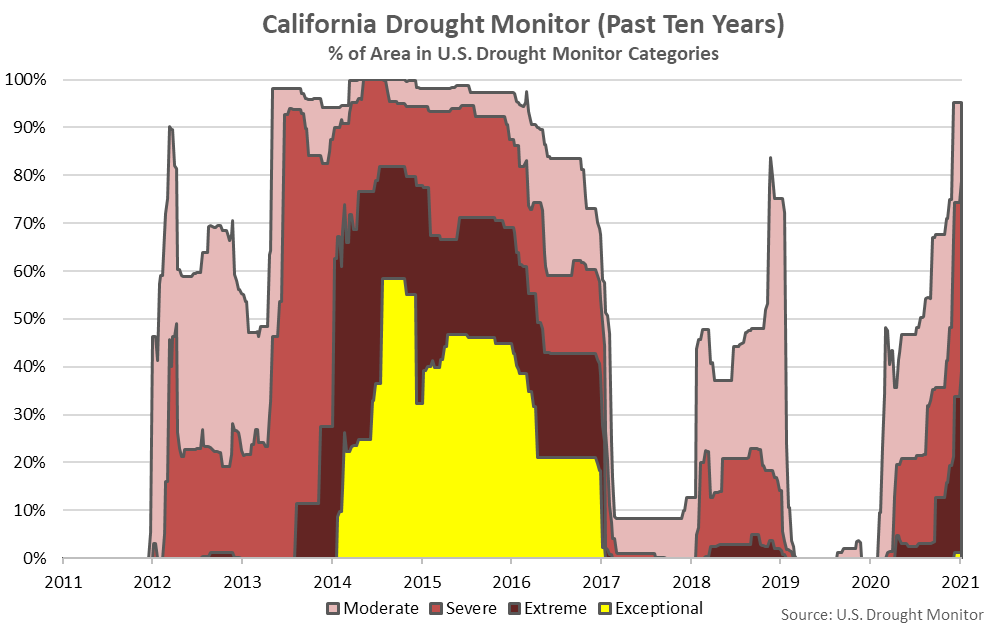 A slow start to the current California wet season is not indicative of a long-term problem as the climate experienced throughout California is one of the most volatile within the U.S., nevertheless, current conditions within California may reduce the strong milk production growth exhibited over the past several months. California has experienced the second largest growth in milk production volumes throughout the past six months of available data through Nov ’20, trailing only Texas.
A slow start to the current California wet season is not indicative of a long-term problem as the climate experienced throughout California is one of the most volatile within the U.S., nevertheless, current conditions within California may reduce the strong milk production growth exhibited over the past several months. California has experienced the second largest growth in milk production volumes throughout the past six months of available data through Nov ’20, trailing only Texas.
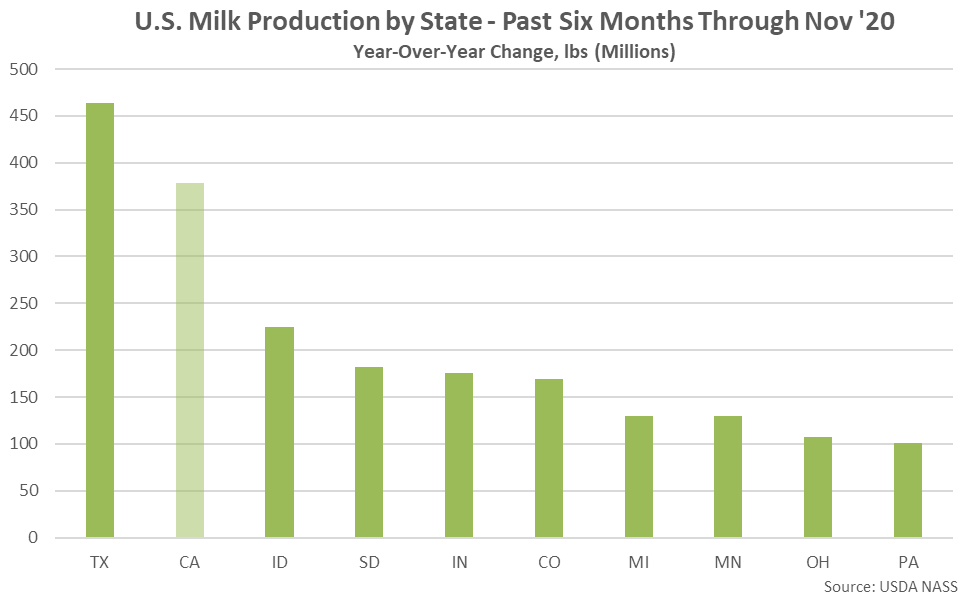
- July – December California cumulative precipitation levels declined to a seven year low level and the third lowest level experienced throughout 126 years of available data.
- Reduced precipitation levels experienced throughout the beginning of the current California wet season have contributed to below average snowpack levels through mid-January. Dec ’20 California snowpack declined to just 45% of normal levels, reaching a three year low seasonal level.
- Recent reductions in precipitation levels have increased drought conditions throughout the vast majority of California. Over 95% of California was deemed to be in a moderate or worse drought through mid-January, reaching a four and a half year high level.
 July – December cumulative precipitation levels have finished below long-term average levels over four consecutive years through 2020. Jul-Dec ’20 cumulative California precipitation levels declined to a seven year low level and the third lowest level experienced throughout 126 years of available data. Cumulative precipitation levels experienced throughout Jul-Dec ’20 finished just 0.04 inches above the record low level experienced throughout 2013, a period that was followed by extreme drought conditions.
July – December cumulative precipitation levels have finished below long-term average levels over four consecutive years through 2020. Jul-Dec ’20 cumulative California precipitation levels declined to a seven year low level and the third lowest level experienced throughout 126 years of available data. Cumulative precipitation levels experienced throughout Jul-Dec ’20 finished just 0.04 inches above the record low level experienced throughout 2013, a period that was followed by extreme drought conditions.
 Precipitation experienced throughout the winter months is typically in the form of snow in the Sierra Nevada Mountains, which serves to refill reservoirs and canals during the summer and early fall months. California snowpack levels typically start to accumulate at the beginning of California’s wet season in early December and peaks in early April following California’s heavy precipitation months. From April to June, warmer temperatures cause the snow to gradually melt and run off, filling the state’s water reservoirs. California relies on the snowpack for water during the dry summer and early fall months, when precipitation levels are at seasonal lows. According to the National Resources Defense Council, on average, snowpack accounts for approximately 30% of the water used by California’s cities and farms each year.
Reduced precipitation levels experienced throughout the current California wet season have contributed to average snowpack declining to a three year low seasonal level through mid-January.
Precipitation experienced throughout the winter months is typically in the form of snow in the Sierra Nevada Mountains, which serves to refill reservoirs and canals during the summer and early fall months. California snowpack levels typically start to accumulate at the beginning of California’s wet season in early December and peaks in early April following California’s heavy precipitation months. From April to June, warmer temperatures cause the snow to gradually melt and run off, filling the state’s water reservoirs. California relies on the snowpack for water during the dry summer and early fall months, when precipitation levels are at seasonal lows. According to the National Resources Defense Council, on average, snowpack accounts for approximately 30% of the water used by California’s cities and farms each year.
Reduced precipitation levels experienced throughout the current California wet season have contributed to average snowpack declining to a three year low seasonal level through mid-January.
 California snowpack levels rebounded to above historical average seasonal December levels for the first time in the past seven years throughout 2019. Dec ’20 California snowpack declined to just 45% of normal levels, however, reaching a three year low seasonal level.
California snowpack levels rebounded to above historical average seasonal December levels for the first time in the past seven years throughout 2019. Dec ’20 California snowpack declined to just 45% of normal levels, however, reaching a three year low seasonal level.
 California Drought Monitor
Increases in precipitation levels experienced throughout the first quarter of 2019 largely eliminated drought conditions throughout the state of California. More recently, reduced precipitation levels have once again increased drought conditions throughout the vast majority of California. Over 95% of California was deemed to be in a moderate or worse drought through mid-January, reaching a four and a half year high level. Nearly 40% of California is currently in an extreme drought classification or worse, reaching a four year high level, while exceptional drought conditions were experienced throughout California for the first time in the past three and a half years during mid-December.
California Drought Monitor
Increases in precipitation levels experienced throughout the first quarter of 2019 largely eliminated drought conditions throughout the state of California. More recently, reduced precipitation levels have once again increased drought conditions throughout the vast majority of California. Over 95% of California was deemed to be in a moderate or worse drought through mid-January, reaching a four and a half year high level. Nearly 40% of California is currently in an extreme drought classification or worse, reaching a four year high level, while exceptional drought conditions were experienced throughout California for the first time in the past three and a half years during mid-December.
 A slow start to the current California wet season is not indicative of a long-term problem as the climate experienced throughout California is one of the most volatile within the U.S., nevertheless, current conditions within California may reduce the strong milk production growth exhibited over the past several months. California has experienced the second largest growth in milk production volumes throughout the past six months of available data through Nov ’20, trailing only Texas.
A slow start to the current California wet season is not indicative of a long-term problem as the climate experienced throughout California is one of the most volatile within the U.S., nevertheless, current conditions within California may reduce the strong milk production growth exhibited over the past several months. California has experienced the second largest growth in milk production volumes throughout the past six months of available data through Nov ’20, trailing only Texas.
